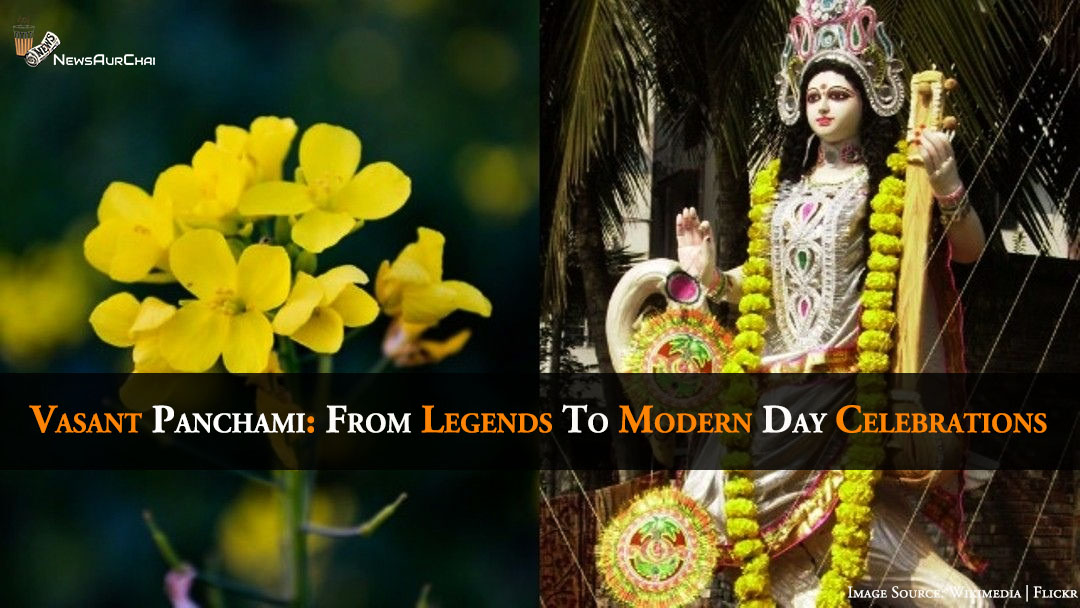
No sooner the festivities of Makar Sankranti die down than we gear up for the next festival on the list—Vasant Panchami, marking the advent of Spring—the “King of seasons”—bringing new life, greenery, end of ignorance. It is celebrated on the 5th day of the bright half of the Hindu luni-solar calendar month of Magha. Mango flowers start blossoming, mustard crop ripens, and nature envelopes itself in hues of vibrant yellow, orange, and green. The Goddess of knowledge, wisdom, arts, music, Saraswati is worshipped on this day to initiate spiritual awakening. Preparations of Holika Dahan and Holi which occur after 40 days of Vasant Panchami, also begin.
Celebrations across Regions and Religions:
Believed to commemorate the birth anniversary of Saraswati, the Goddess is invoked in Bengal, Bihar, and northeast. The deity Deo-Sun is worshipped in Aurangabad, while Lord Shiva, Parvati, and Kamadeva are also worshipped. In Kutch, Gujarat, it is associated with the celebration of love, symbolising Krishna-Radha and Kama-Rati.
Interestingly, the colours of spring are not only restricted to India—we find Bangladesh and Indonesia joining the festivities. Predominantly a Hindu festival, the advent of spring is manifested in other religions as well. In Nepal, Buddhists offer prayers to Manjushri, Goddess of wisdom; in Pakistan, Punjabi Muslims fly kites; Sufi Basant, adopted by the Indian Muslims in the 12th century to mark the grave of the Muslim Sufi Saint Dargah of Nizamuddin Aulia in Delhi, is celebrated; Sikhs engage in kite-flying, inducted by Maharaja Ranjit Singh, founder of the Sikh-empire.
In pre-Partition India, Basant was celebrated by Hindus, Muslims, Sikhs together. Usha Kumar, general-secretary of Anjuman Sair-e-Gul Faroshan, an organisation trying to revive this spirit, says, “Participants walk through Chandni Chowk holding floral pankhas with images of Saraswati and the sacred Kabah, decorated with yellow flowers. They offer a canopy made of marigold and mustard blossom to Saraswati at the Gauri-Shankar Mandir. The procession, accompanied by shehnai and dhol-tasha players, then proceeds to the Nizamuddin Dargah to offer a chaddar made of yellow flowers at the mazaar of Nizamuddin Aulia and Amir Khusro.”
Lesser-known Legends:
- According to Ramayana, on Vasant Panchami Lord Rama, while in exile, tasted the half-eaten berries offered by the elderly ascetic Shabri.
- The marriage of Guru Gobind Singh is marked on this day every year in Bilaspur by a fair in Gurudwara Guru_ka_lahore.
- Popular folklore says renowned poet Kalidasa was a simpleton who attained knowledge and wisdom by the appearance of goddess Saraswati. It is believed that the Goddess bestows similar gifts on her devotees who worship her on this day.
- Aryans are believed to have crossed the Khyber Pass on this day arriving at the banks of River Saraswati.
Things to do:
Yellow, Saraswati’s favourite colour, is the traditional colour of Vasant. On this day, don your best clothing in the shades of yellow and join your family to welcome spring. Sweet yellow rice, Kesar laddoo, khichdi are prepared and by adding a tinge of saffron or turmeric, these mouth-watering items can become colour-coordinated too. The initiative to promote education for all can be adopted—join hands with NGOs and social workers in distributing books, stationeries, musical instruments to the underprivileged section.
Lastly, this day is widely popular as pre-Valentine’s day, so spend some quality time with your loved ones before the month of love arrives, and make Vasant Panchami special. Do something good for the society this Vasant Panchami, bring out the smile among those underprivileged people.





